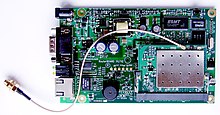


A wireless Internet service provider (WISP) is an Internet service provider with a network based on wireless networking. Technology may include commonplace Wi-Fi wireless mesh networking, or proprietary equipment designed to operate over open 900 MHz, 2.4 GHz, 4.9, 5, 24, and 60 GHz bands or licensed frequencies in the UHF band (including the MMDS frequency band), LMDS, and other bands from 6 GHz to 80 GHz.
In the US, the Federal Communications Commission (FCC) released a Report and Order, FCC 05-56 in 2005 that revised the FCC’s rules to open the 3650 MHz band for terrestrial wireless broadband operations.[1] On November 14, 2007 the Commission released a Public Notice (DA 07-4605) in which the Wireless Telecommunications Bureau announced the start date for the licensing and registration process for the 3650-3700 MHz band.[2]
As of July 2015, over 2,000 fixed wireless broadband providers operate in the US, servicing nearly 4 million customers.[3]
- ^ "FCC: Wireless Services: 3650-3700 MHz Radio Service". Federal Communications Commission. Retrieved 2008-03-17.
- ^ "PUBLIC NOTICE - Released: November 14, 2007" (PDF). Federal Communications Commission. Retrieved 2008-03-17.
- ^ "Industry Resources - Wireless Internet Service Providers Association". www.wispa.org. Retrieved 2020-07-10.